
Overhill Cherokee
Encyclopedia
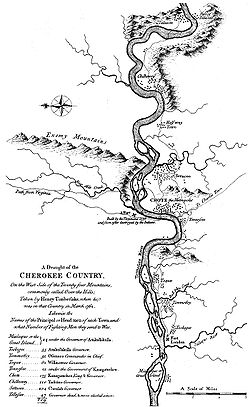
Cherokee
The Cherokee are a Native American people historically settled in the Southeastern United States . Linguistically, they are part of the Iroquoian language family...
settlements located in what is now Tennessee
Tennessee
Tennessee is a U.S. state located in the Southeastern United States. It has a population of 6,346,105, making it the nation's 17th-largest state by population, and covers , making it the 36th-largest by total land area...
in the southeastern United States. The name was given by 18th century European traders and explorers who had to cross the Appalachian Mountains
Appalachian Mountains
The Appalachian Mountains #Whether the stressed vowel is or ,#Whether the "ch" is pronounced as a fricative or an affricate , and#Whether the final vowel is the monophthong or the diphthong .), often called the Appalachians, are a system of mountains in eastern North America. The Appalachians...
to reach these settlements when traveling from British
British North America
British North America is a historical term. It consisted of the colonies and territories of the British Empire in continental North America after the end of the American Revolutionary War and the recognition of American independence in 1783.At the start of the Revolutionary War in 1775 the British...
colonies along the Atlantic coast.
Situated along the lower Little Tennessee
Little Tennessee River
The Little Tennessee River is a tributary of the Tennessee River, approximately 135 miles long, in the Appalachian Mountains in the southeastern United States.-Geography:...
, lower Tellico
Tellico River
The Tellico River rises in the westernmost mountains of North Carolina, but it flows mainly through Monroe County, Tennessee. It is a major tributary of the Little Tennessee River and the namesake of Tellico Reservoir, a reservoir created by Tellico Dam, which impounds the lower reaches of the...
, and lower Hiwassee
Hiwassee River
The Hiwassee River has its headwaters on the north slope of Rocky Mountain in Towns County in northern Georgia and flows northward into North Carolina before turning westward into Tennessee, flowing into the Tennessee River a few miles west of State Route 58 in Meigs County, Tennessee...
rivers, the Overhill towns rose to prominence within the Cherokee Nation in the early 18th century when trade with the British was standardized. In the early part of the century, the Overhill towns' remote location at the far end of the Trading Path
Trading Path
The Trading Path is not simply one wide path, as many named historic roads were or are...
made them accessible only to those traders and explorers adventurous and opportunistic enough to make the treacherous journey inland and over the mountains. By the middle of the century, the Overhill towns were consistently courted by both British and French emissaries as the two powers struggled for the control of the continent. In the late 18th century and early 19th century, the westward thrust of Euro-American settlement led to the decline of the Overhill towns, as the Cherokee were induced to sign away the bulk of their lands in the east in a series of unfavorable treaties.
The Overhill town of Chota
Chota (Cherokee town)
Chota is a historic Overhill Cherokee site in Monroe County, Tennessee, in the southeastern United States. For much of its history, Chota was the most important of the Overhill towns, serving as the de facto capital of the Cherokee people from the late 1740s until 1788...
in present-day Monroe County, Tennessee was recognized as the de facto capital of the Cherokee Nation for most of the 18th century, and the town of Tanasi
Tanasi
Tanasi is a historic Overhill Cherokee village site in Monroe County, Tennessee, in the southeastern United States. The village is best known as the namesake for the state of Tennessee...
would become the namesake for the state of Tennessee. Many prominent Cherokee leaders, including Attakullakulla
Attacullaculla
Attakullakulla or Atagulkalu , adopted as an infant into the Cherokee tribe, became their First Beloved Man, serving from 1761 to around 1775...
, Oconastota, Nancy Ward
Nancy Ward
Nanyehi , known in English as Nancy Ward was a Ghigau, or Beloved Woman of the Cherokee Nation, which meant that she was allowed to sit in councils and to make decisions, along with the other Beloved Women, on pardons...
, and Sequoyah
Sequoyah
Sequoyah , named in English George Gist or George Guess, was a Cherokee silversmith. In 1821 he completed his independent creation of a Cherokee syllabary, making reading and writing in Cherokee possible...
were born and raised in Overhill towns. Although most of the Overhill sites were submerged by the impoundment of the Little Tennessee River in the 1970s, archaeologists conducted pre-inundation excavations identifying most of the Overhill towns and extracting volumes of invaluable information regarding the region's Cherokee and pre-Cherokee inhabitants.
Geographic area
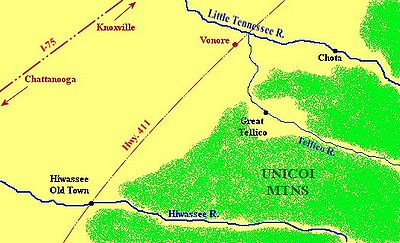
Great Smoky Mountains
The Great Smoky Mountains are a mountain range rising along the Tennessee–North Carolina border in the southeastern United States. They are a subrange of the Appalachian Mountains, and form part of the Blue Ridge Physiographic Province. The range is sometimes called the Smoky Mountains or the...
and the Unicoi Mountains
Unicoi Range
The Unicoi Mountains are a mountain range rising along the border between Tennessee and North Carolina in the southeastern United States. They are part of the Blue Ridge Mountain Province of the Southern Appalachian Mountains. The Unicois are located immediately south of the Great Smoky Mountains...
, in what is now Monroe and Polk counties. The northernmost of these three rivers, the Little Tennessee
Little Tennessee River
The Little Tennessee River is a tributary of the Tennessee River, approximately 135 miles long, in the Appalachian Mountains in the southeastern United States.-Geography:...
, was the locus for a string of prominent Overhill settlements situated between modern-day Vonore
Vonore, Tennessee
Vonore is a town in Blount and Monroe counties in the U.S. state of Tennessee. The population was 1,162 as of the 2000 census.-Geography:Vonore is located at ....
and Calderwood Dam
Calderwood Dam
Calderwood Dam is a hydroelectric dam located along the Little Tennessee River in Blount and Monroe counties, Tennessee. Completed in 1930, the dam is owned and maintained by Tapoco, a subsidiary of the Aluminum Company of America , although the Tennessee Valley Authority controls the dam's...
. Other important settlements were situated along the Hiwassee River
Hiwassee River
The Hiwassee River has its headwaters on the north slope of Rocky Mountain in Towns County in northern Georgia and flows northward into North Carolina before turning westward into Tennessee, flowing into the Tennessee River a few miles west of State Route 58 in Meigs County, Tennessee...
south of modern Etowah
Etowah, Tennessee
Etowah is a city in McMinn County, Tennessee, United States. The population was 3,663 at the 2000 census.-History:Etowah was founded in 1906, primarily as a location for a depot on the Louisville & Nashville Railroad line as part of a more direct route between Atlanta, Georgia and Cincinnati, Ohio...
and along the Tellico River
Tellico River
The Tellico River rises in the westernmost mountains of North Carolina, but it flows mainly through Monroe County, Tennessee. It is a major tributary of the Little Tennessee River and the namesake of Tellico Reservoir, a reservoir created by Tellico Dam, which impounds the lower reaches of the...
in modern Tellico Plains
Tellico Plains, Tennessee
Tellico Plains is a town in Monroe County, Tennessee, United States. The population was 859 at the 2000 census.-Geography:Tellico Plains is located at ....
.
Although most of the Tennessee side of the Great Smoky Mountains was used primarily as a hunting ground, early Euro-American explorers recalled abandoned villages and temporary hunting camps scattered around the region. These were often found in the game-rich cove
Cove (Appalachian Mountains)
In the central and southern Appalachian Mountains of Eastern North America, a cove is a small valley between two ridge lines that is closed at one or both ends....
s of the northern part of the range and near the junctions of major streams.
Prominent Overhill villages
Great TellicoGreat Tellico
Great Tellico was a Cherokee town at the site of present-day Tellico Plains, Tennessee, where the Tellico River emerges from the Appalachian Mountains. Great Tellico was one of the largest Cherokee towns in the region, and had a sister town nearby named Chatuga. Its name in Cherokee is more...
(Talikwa) – located in present-day Monroe County, Tennessee, in Tellico Plains, where the Tellico River levels out at the base of the Unicoi Mountains. Great Tellico rose to prominence in early 18th century under its chief, Moytoy II
Moytoy II
Moytoy of Tellico was a Cherokee leader from Great Tellico, to whom Sir Alexander Cumming, a trade envoy from the Province of South Carolina gave the title "Emperor of the Cherokee". The Cherokee themselves used the title "First Beloved Man"...
. Alexander Cuming, who visited the town in 1730, reported that Great Tellico had the fiercest warriors of all the Overhill towns. The site of the town is located in modern Tellico Plains, Tennessee. Great Tellico's sister town, Chatuga, was also located in the valley. 35.36627°N 84.28745°W
Chota
Chota (Cherokee town)
Chota is a historic Overhill Cherokee site in Monroe County, Tennessee, in the southeastern United States. For much of its history, Chota was the most important of the Overhill towns, serving as the de facto capital of the Cherokee people from the late 1740s until 1788...
(Itsa'sa) – located in present-day Monroe County, Tennessee, along the Little Tennessee River, about 10 miles (16 km) south of modern-day Vonore. Chota was the de facto Cherokee capital in the mid-18th century, and birthplace of several prominent chiefs. At the time of Timberlake's visit in 1761, Chota consisted of a large councilhouse that could seat 500 and about 60 houses. The town's name is sometimes spelled "Echota." 35.55507°N 84.13104°W
Tanasi
Tanasi
Tanasi is a historic Overhill Cherokee village site in Monroe County, Tennessee, in the southeastern United States. The village is best known as the namesake for the state of Tennessee...
– located in present-day Monroe County, Tennessee, adjacent to Chota along the Little Tennessee River. The town was the capital of the Overhill Cherokee c. 1721–1730. The Little Tennessee was originally simply called the "Tennessee," which was an alternate spelling of "Tanasi." The name was eventually applied to the entire state. 35.55005°N 84.13374°W
Tuskegee
Tuskegee, Tennessee
Tuskegee was an Overhill Cherokee village originally on the bank of the Little Tennessee River at the mouth of the Tellico River. Today the site lies under the artificial lake, Tellico Reservoir, created by Tellico Dam....
(Taskigi) – located at the confluence of the Tellico River and Little Tennessee River south of modern-day Fort Loudoun State Park
Fort Loudoun State Park
Fort Loudoun State Park is a state park in Monroe County in the U.S. state of Tennessee. It houses the reconstructed Fort Loudoun along with an interpretive center and recreation area, and the remains of the Tellico Blockhouse....
. Tuskegee was the birthplace of Sequoyah
Sequoyah
Sequoyah , named in English George Gist or George Guess, was a Cherokee silversmith. In 1821 he completed his independent creation of a Cherokee syllabary, making reading and writing in Cherokee possible...
. 35.59167°N 84.20222°W
Citico
Citico (Tellico archaeological site)
Citico is a prehistoric and historic Native American site in Monroe County, Tennessee, in the southeastern United States. The site's namesake Cherokee village was the largest of the Overhill towns, housing an estimated population of 1,000 by the mid-18th century...
(Si'tiku) – located in present-day Monroe County, Tennessee, at the confluence of Citico Creek and the Little Tennessee River. The town's name is sometimes spelled "Settaco." 35.54887°N 84.09891°W
Tallassee
Tallassee (Cherokee town)
Tallassee is a prehistoric and historic Native American site in Blount County and Monroe County, Tennessee, in the southeastern United States. Tallassee was the southernmost of a string of Overhill Cherokee villages that spanned the lower Little Tennessee River in the 18th century...
(Ta'lasi) – located in present-day Blount
Blount County, Tennessee
Blount County is a U.S. county located in the U.S. state of Tennessee. Its population was 123,010 at the United States Census, 2010. The county seat is at Maryville, which is also the county's largest city....
and Monroe counties along the Little Tennessee River a mile or so downstream from modern Calderwood Dam. The modern town of Tallassee is situated much further downstream, and its location should not be confused with that of the ancient village. Tallassee is sometimes called "Tallassee Old Town." 35.50556°N 84.00028°W
Chilhowee
Chilhowee (Cherokee town)
Chilhowee was a prehistoric and historic Native American site in Blount County and Monroe County, Tennessee, in the southeastern United States...
(Tsu'lun'we) – located in present-day Blount
Blount County, Tennessee
Blount County is a U.S. county located in the U.S. state of Tennessee. Its population was 123,010 at the United States Census, 2010. The county seat is at Maryville, which is also the county's largest city....
and Monroe counties at the confluence of Abrams Creek and the Little Tennessee River, near the junction of modern U.S. Route 129
U.S. Route 129
U.S. Route 129 is an offshoot route of U.S. Route 29, which it intersects near Athens, Georgia. US 129 currently runs for 582 miles from Knoxville, Tennessee, to Chiefland, Florida, at U.S. Route 19 and U.S. Route 98. It passes through the states of Tennessee, North Carolina, Georgia and Florida...
and Foothills Parkway
Foothills Parkway
The Foothills Parkway is a national parkway which, if completed, will traverse the foothills of the northern Great Smoky Mountains in East Tennessee, located in the Southeastern United States. The 71-mile parkway will ideally connect U.S...
. 35.55231°N 84.00737°W
Toqua
Toqua (Tennessee)
Toqua is a prehistoric and historic Native American site in Monroe County, Tennessee, located in the southeastern United States. Along with the Overhill Cherokee village for which the site was named, Toqua was home to a substantial pre-Cherokee town that thrived during the Mississippian period...
(Dakwa) – located in present-day Monroe County, Tennessee, at the confluence of Toco Creek and the Little Tennessee River, just south of modern-day Fort Loudoun State Park. 35.56984°N 84.17248°W

Tomotley
Tomotley is a prehistoric and historic Native American site in Monroe County, Tennessee, in the southeastern United States. Occupied as early as the Archaic period, the Tomotley site had the most substantial periods of habitation during the Mississippian period, likely when the earthwork mounds...
– located in present-day Monroe County, Tennessee, adjacent to Toqua along the Little Tennessee River. Timberlake reported a councilhouse in Tomotley that would sound a "death hallow" to signify the return of a war party. 35.57182°N 84.18697°W
Mialoquo
Mialoquo
Mialoquo is a prehistoric and historic Native American site in Monroe County, Tennessee, in the southeastern United States. The site saw significant periods of occupation during the Mississippian period and later as a Cherokee refugee village...
(Amaye'le'gwa) – located in present-day Monroe County, Tennessee, on a now-submerged island in the middle of the Little Tennessee River, just north of the modern U.S. Route 411
U.S. Route 411
U.S. Highway 411 is an alternate parallel-highway associated with U.S. Highway 11. U.S. 411 extends for about 313 miles from U.S. Route 78 in Leeds, Jefferson County, Alabama, to U.S. Highway 25 in Newport, Cocke County, Tennessee. U.S. 411 passes through the northeastern State of Alabama, the...
bridge. Mooney believed Mialoquo might have been the village of Nilaque, visited by John Bartram
John Bartram
*Hoffmann, Nancy E. and John C. Van Horne, eds., America’s Curious Botanist: A Tercentennial Reappraisal of John Bartram 1699-1777. Memoirs of the American Philosophical Society, vol. 243. ....
. The term "Mialoquo" means "Great Island." 35.61534°N 84.24048°W
Great Hiwassee
Great Hiwassee
Great Hiwassee was an important Overhill Cherokee town from the late 17th through the early 19th centuries. It was located on the Hiwassee River in present-day Polk County, Tennessee, on the north bank of the river where modern U.S. Route 411 crosses the river...
(Ayouwasi) – located in present-day Polk County, Tennessee, along the Hiwassee River at the base of the Unicoi Mountains, where the river levels into a fertile plain. The site is now farmland. The term "Hiwassee" means "savanna" or "plain." Hiwassee is sometimes called "Hiwassee Old Town." 35.24314°N 84.58149°W
Trails and paths
The Overhill settlements were connected by a series of well-worn trails:- The Great Indian WarpathGreat Indian WarpathThe Great Indian Warpath — also known as the Great Indian War and Trading Path, or the Seneca Trail — was that part of the network of trails in eastern North America developed and used by Native Americans which ran through the Great Appalachian Valley...
ran parallel to the base of the Appalachians, connecting the Overhill settlements to Cherokee villages in GeorgiaGeorgia (U.S. state)Georgia is a state located in the southeastern United States. It was established in 1732, the last of the original Thirteen Colonies. The state is named after King George II of Great Britain. Georgia was the fourth state to ratify the United States Constitution, on January 2, 1788...
and VirginiaVirginiaThe Commonwealth of Virginia , is a U.S. state on the Atlantic Coast of the Southern United States. Virginia is nicknamed the "Old Dominion" and sometimes the "Mother of Presidents" after the eight U.S. presidents born there...
.
- The Trading PathTrading PathThe Trading Path is not simply one wide path, as many named historic roads were or are...
(later called the Unicoi Turnpike) connected the Overhill towns with the Middle settlements in North Carolina, the Lower towns in South Carolina, and extended all the way to CharlestonCharleston, South CarolinaCharleston is the second largest city in the U.S. state of South Carolina. It was made the county seat of Charleston County in 1901 when Charleston County was founded. The city's original name was Charles Towne in 1670, and it moved to its present location from a location on the west bank of the...
.
- The Warriors' Path connected Hiwassee Old Town, Great TellicoGreat TellicoGreat Tellico was a Cherokee town at the site of present-day Tellico Plains, Tennessee, where the Tellico River emerges from the Appalachian Mountains. Great Tellico was one of the largest Cherokee towns in the region, and had a sister town nearby named Chatuga. Its name in Cherokee is more...
, and ChotaChota (Cherokee town)Chota is a historic Overhill Cherokee site in Monroe County, Tennessee, in the southeastern United States. For much of its history, Chota was the most important of the Overhill towns, serving as the de facto capital of the Cherokee people from the late 1740s until 1788...
, which were the main villages along the three rivers in the Overhill country.
- A branch of the Tuckaleechee and Southeastern Trail connected the Overhill towns along the Upper Little Tennessee with the Kitawha towns in North Carolina via Tuckaleechee Cove, Cades CoveCades CoveCades Cove is an isolated valley located in the Tennessee section of Great Smoky Mountains National Park, USA. The valley was home to numerous settlers before the formation of the national park...
and Ekaneetlee Gap (near Gregory BaldGregory BaldGregory Bald is a mountain on the western fringe of the Great Smoky Mountains. It has an elevation of 4,949 feet above sea level. The mountain's majestic summit makes it a popular hiking destination....
).
History
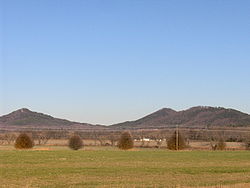
Nikwasi
Nikwasi was an important Cherokee town located on the Little Tennessee River at the site of present-day Franklin, North Carolina....
and Tassetchee amidst the Great Balsam Mountains
Great Balsam Mountains
The Great Balsam Mountains, or Balsam Mountains, are in the mountain region of western North Carolina, United States. The Great Balsams are a subrange of the Blue Ridge Mountains, which in turn are a part of the Appalachian Mountains...
and eastern Unicoi Mountains in North Carolina. The Overhill Cherokee lived in settlements located between the Appalachian Mountains and the Tennessee Valley in what is now Tennessee. The Overhill capital, or "mother town," shifted between Great Tellico, Tanasi, and Chota.
The Overhill settlements were established sometime between the late 16th century and the late 17th century, although scholars disagree as to a more exact timeframe. The major towns were in place by the time the first Euro-American explorers arrived in the late 17th century, and the Overhill Cherokee spoke in a dialect distinctive from that found in the Middle settlements and Lower towns.
Early accounts
For most of the 17th century, the British colonies on the Atlantic coast dealt with the Cherokee via other tribes acting as middlemen. As the market for fur in Europe grew, however, the need for direct contact with tribes further and further west drew early traders and trappers to the Overhill settlements. In 1673, VirginiaVirginia
The Commonwealth of Virginia , is a U.S. state on the Atlantic Coast of the Southern United States. Virginia is nicknamed the "Old Dominion" and sometimes the "Mother of Presidents" after the eight U.S. presidents born there...
merchants sent agents James Needham and Gabriel Arthur on trip west of the Appalachians, hoping to open a direct trade route. While Needham was killed on the return trip, Arthur stayed behind and claimed to have accompanied the natives (possibly the Cherokee) on raids of Spanish settlements in Florida.
In 1725, South Carolina
South Carolina
South Carolina is a state in the Deep South of the United States that borders Georgia to the south, North Carolina to the north, and the Atlantic Ocean to the east. Originally part of the Province of Carolina, the Province of South Carolina was one of the 13 colonies that declared independence...
sent Col. George Chicken on a diplomatic mission to the Overhill towns to address the issue of unlicensed traders, who were underselling merchants conducting business legally. Chicken arrived in Great Tellico in July, and described the village as "compact and thick settled," probably in response to the dangers the town faced during tribe's long-time struggle with the Creek tribe. Chicken then followed the Warriors' Path north to the Little Tennessee, where he met the "Head Warrior" of Tanasi and the chiefs of Citico and Tallassee.
Alexander Cuming, 1730
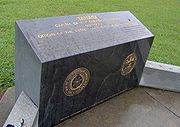
Charleston, South Carolina
Charleston is the second largest city in the U.S. state of South Carolina. It was made the county seat of Charleston County in 1901 when Charleston County was founded. The city's original name was Charles Towne in 1670, and it moved to its present location from a location on the west bank of the...
in December 1729. Although he lacked any real diplomatic credentials, Cuming managed to convince several Charlestonians that he was an agent of King George II of Great Britain
George II of Great Britain
George II was King of Great Britain and Ireland, Duke of Brunswick-Lüneburg and Archtreasurer and Prince-elector of the Holy Roman Empire from 11 June 1727 until his death.George was the last British monarch born outside Great Britain. He was born and brought up in Northern Germany...
on a mission to gain the loyalty of the Cherokee. Cuming set out for the Overhill town of Tanasi in March 1730, his stated goal being to gain the fabled "Crown of Tannassy."
Cuming moved quickly across the Trading Path, interacting briefly with Lower and Middle chiefs. In just under a month, Cuming had crossed the Unicoi Mountains into the Overhill country, a dangerous place at the time due to the Cherokees' ongoing war with the Creeks.
Cuming's method of securing allegiance was described years later by colonial trader, Ludovick Grant, who lived in Great Tellico and briefly accompanied Cuming during his tour. In each town, Cuming arranged a meeting with local leaders in the townhouse. He arrived at the meeting fully armed, in defiance of custom, and made a prepared speech declaring that he was a private citizen wishing only to see their country, and that if any Indians wished to return to England with him, he would take them. He then asked them to join his party in a toast
Toast (honor)
A toast is a ritual in which a drink is taken as an expression of honor or goodwill. The term may be applied to the person or thing so honored, the drink taken, or the verbal expression accompanying the drink. Thus, a person could be "the toast of the evening," for whom someone "proposes a toast"...
to the health of King George II, and to kneel in allegiance. His intention, as he told his guides, was to set fire to the townhouse and kill the assembled Indians if they refused.
During his stay in Great Tellico, Cuming was impressed by the display of its chief, Moytoy. He described the encounter in his journal (referring to his party in third person):
They arrived at great Telliquo in the Afternoon, saw the petrifying Cave, a great many Enemies Scalps brought in and put upon Poles at the Warriors Doors, made a Friend of the great Moytoy, and Jacob the Conjurer.
Cuming learned that Moytoy was attempting to usurp control of the entire Cherokee people. Cuming agreed to use his influence to help Moytoy in this regard if Moytoy would help him get the Crown of Tanasi. On March 30, Cuming followed the Warriors' Path from Great Tellico to Tanasi, which he found "pleasantly situated" along the Little Tennessee. Cuming met with the Tanasi Warrior, who was a de facto
De facto
De facto is a Latin expression that means "concerning fact." In law, it often means "in practice but not necessarily ordained by law" or "in practice or actuality, but not officially established." It is commonly used in contrast to de jure when referring to matters of law, governance, or...
leader of the Overhill at the time. After gaining the Tanasi Warrior's allegiance, Cuming returned to Great Tellico. He accompanied Moytoy back across the Unicoi Mountains to Nequassee, where Moytoy was crowned "Emperor of the Cherokee."
Cuming returned to England on June 5, 1730 with several Cherokee and a possum-hair headdress he referred to as the "Crown of Tannassy." Although he had planned to present them to King George II, a delegation from Charleston arrived claiming Cuming had defrauded them. While Cuming's schemes led to his own downfall, his visit to the Overhill towns helped to solidify an alliance between the Cherokee and the English.
Christian Priber, 1730s
Around 1736, an utopian idealist named Christian Priber arrived in Great Tellico. Although initially a French agent, Priber quickly abandoned his mission. He adopted Cherokee customs, learned the language, and quickly gained the tribe's trust.Priber attempted to organize Cherokee society in accordance with early 18th century European idealism. He put forward the view that all things should be held in common, including wives and children. Claiming the English were fraudulent and greedy, he suggested moving the Cherokee capital to modern-day Alabama
Alabama
Alabama is a state located in the southeastern region of the United States. It is bordered by Tennessee to the north, Georgia to the east, Florida and the Gulf of Mexico to the south, and Mississippi to the west. Alabama ranks 30th in total land area and ranks second in the size of its inland...
, where it would be closer to French lands. The English attempted to arrest Priber in 1739, but were prevented from doing so by the Cherokee. He was finally captured by the Creek and turned over to South Carolina authorities in 1743.
Fort Loudoun, 1756–1760

John Campbell, 4th Earl of Loudoun
Major-General John Campbell, 4th Earl of Loudoun was a British nobleman and army officer.-Early career:Campbell inherited the peerage on the death of his father in 1731, becoming Lord Loudoun. The earl raised a regiment of infantry that took part in the Jacobite Rising of 1745 on the side of the...
, stood at the junction of the Little Tennessee River and the Tellico River. The Cherokee village of Tuskegee developed in its vicinity.
Shortly after the fort's construction, relations between the English and the Cherokee soured. Several Cherokee returning home from battle were killed, and an increase in horse thefts created tension in Virginia. After a contingent of Cherokee chiefs were detained at Fort Prince George in late 1759, the Cherokee, under Chief Standing Turkey, laid siege to Fort Loudoun. The fort's garrison held out until August 1760, when a lack of provisions forced them to surrender.
Timberlake expedition, 1761

James Grant (general)
James Grant, Laird of Ballindalloch was a major general in the British Army during the American War of Independence. He served as Governor of East Florida from 1763 to 1771.-Early career:...
against the Lower towns, Virginia dispatched Colonel William Byrd
William Byrd III
William Byrd III was the son of William Byrd II and the grandson of William Byrd I. He inherited his family's land in Virginia and continued their planter prestige as a member of the Virginia House of Burgesses.He chose to fight in the French and Indian War rather than spend much time in Richmond...
to attack the Middle towns in North Carolina, and Colonel Adam Stephen
Adam Stephen
Adam Stephen was a Scottish-born doctor and military officer. He came to North America, where he served in the Virginia colonial militia under George Washington during the French and Indian War. He served under Washington again in the American Revolutionary War, rising to lead a division of the...
detached from Byrd's regiment and marched to Long Island of the Holston (near modern-day Kingsport, Tennessee
Kingsport, Tennessee
Kingsport is a city located mainly in Sullivan County with some western portions in Hawkins County in the US state of Tennessee. The majority of the city lies in Sullivan County...
) with plans to attack the Overhill towns. The Cherokee immediately sued for peace, which was granted. To help solidify the peace, Stephen dispatched Lieutenant Henry Timberlake
Henry Timberlake
Henry Timberlake was a colonial Anglo-American officer, journalist, and cartographer. He was born in Virginia in 1730 and died in England...
and Sergeant Thomas Sumter
Thomas Sumter
Thomas Sumter nicknamed the "Carolina Gamecock" , was a hero of the American Revolution and went on to become a longtime member of the Congress of the United States.-Early life:Thomas Sumter was born near Charlottesville in Hanover County, Virginia in 1734...
to accompany a Cherokee delegation on a tour of the Overhill towns.
After a five-day journey down the Holston
Holston River
The Holston River is a major river system of southwestern Virginia and east Tennessee. The three major forks of the Holston rise in southwestern Virginia and have their confluence near Kingsport, Tennessee. The North Fork flows southwest from Sharon Springs in Bland County, Virginia...
, French Broad
French Broad River
The French Broad River flows from near the village of Rosman in Transylvania County, North Carolina, into the state of Tennessee. Its confluence with the Holston River at Knoxville is the beginning of the Tennessee River....
, and Little Tennessee rivers, Timberlake arrived in the Overhill town of Tomotley, where he was greeted by Chief Ostenaco
Ostenaco
Ostenaco , who preferred to go by the warrior's title he earned at any early age, "Mankiller" , also known as Judd's Friend, who lived c...
and witnessed a ceremonial return of a Cherokee war party. After smoking a peace pipe with Ostenaco, Timberlake proceeded southward to Chota, where he was met by some 400 Cherokee. Timberlake smoked a peace pipe with several tribal leaders, and recorded the layout and design of the town's large councilhouse. The following day, Timberlake arrived in the town of Citico, where the residents greeted him with a long dance. After smoking a peace pipe with Citico's chief, Cheulah, Timberlake proceeded southward to Chilhowee, where he gained similar assurances of peace. He then returned via trail to Long Island of the Holston. Timberlake's journals, published in the 1760s, contain detailed descriptions of Cherokee councilhouses, residences, canoes, and other facets of everyday Cherokee life that would later prove invaluable to historians.
The American Revolution
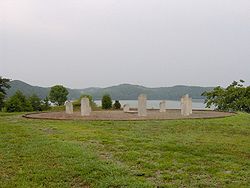
Watauga Association
The Watauga Association was a semi-autonomous government created in 1772 by frontier settlers living along the Watauga River in what is now present day Elizabethton, Tennessee...
. In spite of the agreement, tensions between the pioneers and the Cherokee rose steadily. The outbreak of the American Revolution
American Revolutionary War
The American Revolutionary War , the American War of Independence, or simply the Revolutionary War, began as a war between the Kingdom of Great Britain and thirteen British colonies in North America, and ended in a global war between several European great powers.The war was the result of the...
found the Cherokee once again aligned with the British, this time against the rebellious American colonies.
In 1776, the Cherokee initiated a plan to drive the settlers out of the Washington District, North Carolina
Washington District, North Carolina
The Washington District of North Carolina was in a remote area west of the Appalachian Mountains, officially existing for only a short period of time , although it had been self-proclaimed and functioning as an independent governing entity since the spring of 1775...
and invade Virginia. Virginia merchant, Isaac Thomas— later a co-founder of Sevierville
Sevierville, Tennessee
Sevierville is a city in Sevier County, Tennessee, located in the Southeastern United States. Its population was 11,757 at the 2000 United States Census; in 2004 the estimated population was 14,101. Sevierville is the county seat of Sevier County, Tennessee....
— was warned of the invasion by the Cherokee Beloved Woman, Nancy Ward
Nancy Ward
Nanyehi , known in English as Nancy Ward was a Ghigau, or Beloved Woman of the Cherokee Nation, which meant that she was allowed to sit in councils and to make decisions, along with the other Beloved Women, on pardons...
. Thomas passed on the warning to the settlers, who made adequate preparations. The result was that the first prong of the attack, led by Dragging Canoe
Dragging Canoe
Tsiyu Gansini , "He is dragging his canoe", known to whites as Dragging Canoe, was a Cherokee war chief who led a band of Cherokee against colonists and United States settlers...
, was defeated at Heaton's Station. The second prong, led by Abraham of Chilhowee, was routed at Fort Watauga. In response to these attacks, several thousand militia led by William Christian
William Christian (Virginia)
William Christian was an "Indian fighter", Continental soldier, militiaman and politician from Virginia who served in the era of the American Revolution. He was a signatory to the Fincastle Resolutions and founder of Fort William...
invaded the Overhill towns and burned Tuskegee and Citico. The Cherokee made peace shortly thereafter with the Treaty of De Witt's Corner, although chiefs Dragging Canoe and Ostenaco refused to sign another treaty and fled south to continue the armed struggle —in what became known as the Chickamauga Wars
Chickamauga wars
The Chickamauga Wars were a series of raids, campaigns, ambushes, minor skirmishes, and several full-scale frontier battles which were a continuation of the Cherokee struggle against encroachment by American frontiersmen from the former British colonies...
.
In 1780, while the North Carolina militia from the district, often referred to as the "overhill militia", were away at the Battle of Kings Mountain
Battle of Kings Mountain
The Battle of Kings Mountain was a decisive battle between the Patriot and Loyalist militias in the Southern campaign of the American Revolutionary War...
, the Cherokee launched sporadic raids against the settlers in the Washington District. Upon returning, Colonel John Sevier
John Sevier
John Sevier served four years as the only governor of the State of Franklin and twelve years as Governor of Tennessee. As a U.S. Representative from Tennessee from 1811 until his death...
— who had gained fame as a co-commander at Kings Mountain— was dispatched, along with several thousand militia, to the south on a punitive expedition
Punitive expedition
A punitive expedition is a military journey undertaken to punish a state or any group of persons outside the borders of the punishing state. It is usually undertaken in response to perceived disobedient or morally wrong behavior, but may be also be a covered revenge...
to the Overhill towns. After defeating the Cherokee in a fierce battle at Boyd's Creek
Boyds Creek, Tennessee
Boyds Creek is an unincorporated community in Sevier County, Tennessee, United States. It is named for a small southward-flowing tributary of the French Broad River of the same name, which itself derives its name from a Virginian trader killed by a band of Cherokee Indians whose body was thrown...
(in modern-day Sevier County), Sevier proceeded southward and destroyed most of the remaining, lightly defended villages, including Chota.
The Chickamauga Wars

Chattanooga, Tennessee
Chattanooga is the fourth-largest city in the US state of Tennessee , with a population of 169,887. It is the seat of Hamilton County...
, and set up a series of villages. Although they were still considered Cherokee, they were commonly called the "Chickamauga
Chickamauga Indian
The Chickamauga or Lower Cherokee, were a band of Cherokee who supported Great Britain at the outbreak of the American Revolutionary War. They were followers of the Cherokee chief Dragging Canoe...
" to distinguish them from the greater Cherokee tribe. The Chickamauga (or "Lower Cherokee" as they were also sometimes called) proceeded to carry on an unconventional war against the encroaching Euro-American settlers, ambushing small patrols and attacking small settlements. After Oconastota's death in the early 1780s, Chief Old Tassel was recognized as the leader of the Overhill Cherokee, and sought to distance himself from the Chickamauga. After an expedition by Sevier destroyed the Chickamauga towns in 1782, Dragging Canoe moved the Chickamaugas to modern-day Marion County, Tennessee
Marion County, Tennessee
Marion County is a county located in the U.S. state of Tennessee. As of 2000, the population was 27,776. Its county seat is Jasper.Marion County is part of the Chattanooga, TN–GA Metropolitan Statistical Area.-Geography:According to the U.S...
, where he continued his struggle.
In 1788, a renegade band of Cherokees massacred the family of John Kirk on Nine Mile Creek (in modern Blount County, Tennessee), enraging the already uneasy settlers. Sevier rallied the militia at Hunter's Station (near Maryville) and marched across Chilhowee Mountain
Chilhowee Mountain
Chilhowee Mountain is a low ridge at the outer edge of the Great Smoky Mountains that stretches between the Little Tennessee River to the west and the Little Pigeon River watershed to the east...
to the Little Tennessee River. After capturing and burning Tallassee, Sevier entered Chilhowee and placed Abraham of Chilhowee and Old Tassel under arrest while a truce was being negotiated. One of John Kirk's surviving sons managed to gain access to the chiefs, however, and tomahawked both of them to death. The killing of chiefs under a flag of truce was considered a grave insult by the Cherokee, and the dwindling power of the Chickamaugas was suddenly revived.
After the massacre at Chilhowee, John Watt (Old Tassel's son) and Doublehead (Old Tassel's brother) aligned themselves with Dragging Canoe and carried on a protracted series of attacks against the settlers. Sevier again marched south, capturing and burning several villages before being forced to turn back. Although Dragging Canoe died in 1792, John Watt and Doublehead continued to make sporadic attacks against Euro-American settlements, although these had mostly shifted to the Cumberland
Cumberland Plateau
The Cumberland Plateau is the southern part of the Appalachian Plateau. It includes much of eastern Kentucky and western West Virginia, part of Tennessee, and a small portion of northern Alabama and northwest Georgia . The terms "Allegheny Plateau" and the "Cumberland Plateau" both refer to the...
region.
The Tellico Agency
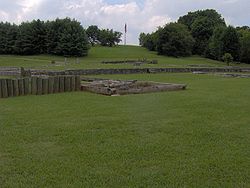
Hanging Maw
Hanging Maw, or Uskwa'li-gu'ta in Cherokee, was the leading chief of the Overhill Cherokee from 1788 to 1794. They were located in present-day Tennessee...
was recognized as the leader of the Overhill towns. With violence spiraling out of control, Hanging Maw petitioned the territorial governor, William Blount
William Blount
William Blount, was a United States statesman. He was a delegate to the Constitutional Convention for North Carolina, the first and only governor of the Southwest Territory, and Democratic-Republican Senator from Tennessee . He played a major role in establishing the state of Tennessee. He was the...
, for a fort to protect the peaceful Overhill villages from vengeful settlers. In 1794, Hanging Maw donated land at the junction of Nine Mile Creek and the Little Tennessee River to the U.S. government for the construction of the Tellico Blockhouse
Tellico Blockhouse
The Tellico Blockhouse was an early American outpost located along the Little Tennessee River in Vonore, Monroe County, Tennessee. Completed in 1794, the blockhouse operated until 1807 with the purpose of keeping the peace between nearby Overhill Cherokee towns and early Euro-American settlers in...
.
Along with a small garrison of federal soldiers, the Tellico Blockhouse was the headquarters of the Tellico Agent— the official liaison between the U.S. and the Cherokee. On November 8, 1794, William Blount met Hanging Maw (representing the Overhill Cherokee) and John Watt (representing the Lower Cherokee) to sign a treaty ending the Chickamauga Wars. Over the next ten years, several other treaties followed in which Cherokee leaders signed away large portions of land in East and Middle Tennessee, including the Overhill towns along the Little Tennessee. With the cession of Overhill lands, the Cherokee Nation
Cherokee Nation (19th century)
The Cherokee Nation of the 19th century —an historic entity —was a legal, autonomous, tribal government in North America existing from 1794–1906. Often referred to simply as The Nation by its inhabitants, it should not be confused with what is known today as the "modern" Cherokee Nation...
's center of power shifted south to New Echota
New Echota
New Echota was the capital of the Cherokee Nation prior to their forced removal in the 1830s. New Echota is 3.68 miles north of present-day Calhoun, Georgia, and south of Resaca, Georgia. The site is a state park and an historic site....
in Georgia
Georgia (U.S. state)
Georgia is a state located in the southeastern United States. It was established in 1732, the last of the original Thirteen Colonies. The state is named after King George II of Great Britain. Georgia was the fourth state to ratify the United States Constitution, on January 2, 1788...
.
The Overhill sites today
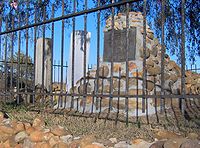
Tennessee Valley Authority
The Tennessee Valley Authority is a federally owned corporation in the United States created by congressional charter in May 1933 to provide navigation, flood control, electricity generation, fertilizer manufacturing, and economic development in the Tennessee Valley, a region particularly affected...
began construction on Tellico Dam
Tellico Dam
Tellico Dam is a dam built by the Tennessee Valley Authority in Loudon County, Tennessee on the Little Tennessee River just above the main stem of the Tennessee River. It impounds the Tellico Reservoir....
just above the mouth of the Little Tennessee. The impoundment created Tellico Lake
Tellico Reservoir
Tellico Reservoir, also known as Tellico Lake, is a reservoir in Tennessee, created by the Tennessee Valley Authority in 1979 upon the completion of Tellico Dam. The dam impounds the Little Tennessee River and the lower Tellico River...
and effectively flooded all of the original Overhill sites along the Little Tennessee River. Before the flooding, however, the University of Tennessee
University of Tennessee
The University of Tennessee is a public land-grant university headquartered at Knoxville, Tennessee, United States...
conducted extensive archaeological excavations, identifying Chota's townhouse and the grave of Oconastota. The site of Chota's townhouse was covered with fill, raising it above water levels. A monument with eight pillars— one for the Cherokee Nation and each of its seven clans— was placed at the site along with Oconastota's grave. Nearby, a small monument was erected marking the site of Tanasi, and recalling it as the root of the state's name. Both sites are managed by the Eastern Band of the Cherokee.
Further upstream, the now-submerged site of Chilhowee has lent its name to Chilhowee Dam
Chilhowee Dam
Chilhowee Dam is a hydroelectric dam located in Blount and Monroe counties, Tennessee, between river mile 33 and 34 on the Little Tennessee River. Construction began in 1955 and was completed in 1957. The dam's reservoir covers approximately at normal full pool and has a drainage area of . The...
. Tennessee Reservoir Development Agency (TRDA) boat ramps have been named after both Toqua and Tallassee. Abrams Creek, which traverses Cades Cove
Cades Cove
Cades Cove is an isolated valley located in the Tennessee section of Great Smoky Mountains National Park, USA. The valley was home to numerous settlers before the formation of the national park...
and empties into the Little Tennessee, is named after Abraham of Chilhowee.
Fort Loudoun State Park
Fort Loudoun State Park
Fort Loudoun State Park is a state park in Monroe County in the U.S. state of Tennessee. It houses the reconstructed Fort Loudoun along with an interpretive center and recreation area, and the remains of the Tellico Blockhouse....
now contains a reconstructed version of the fort and a replica of a 17th century Tuskegee village dwelling. The state park also manages the Tellico Blockhouse site, the foundations of which have been identified and marked. The Sequoyah Birthplace Museum, near Fort Loudoun in Vonore, is dedicated to the inventor of the Cherokee alphabet. The Unicoi Trail, a cross-country hiking trail, now connects the Sequoyah Museum with Murphy, North Carolina
Murphy, North Carolina
-Household Income:The median income for a household in the town was $24,952, and the median income for a family was $35,234. Males had a median income of $30,395 versus $16,908 for females. The per capita income for the town was $16,926...
, roughly following the ancient Trading Path. The Frank H. McClung Museum
Frank H. McClung Museum
The Frank H. McClung Museum is a general museum located on the campus of the University of Tennessee in Knoxville. Built in 1963, exhibits focus on natural history, archeology, anthropology, decorative arts, and local history...
at the University of Tennessee contains hundreds of Cherokee artifacts obtained from various excavations the university has conducted in the Tennessee Valley over the past century.
Prominent Overhill Cherokee figures

- Moytoy of Tellico (c. 1687–1760) – head chief at Great Tellico at the time of Cuming's visit
- Moytoy of Citico; began the Anglo-Cherokee WarAnglo-Cherokee WarThe Anglo-Cherokee War , also known as the Cherokee War, the Cherokee Uprising, the Cherokee Rebellion, was a conflict between British forces in North America and Cherokee Indians during the French and Indian War...
- Jacob the Conjurer (fl. ca. 1730) – in Great Tellico at the time of Cumming's visit
- OstenacoOstenacoOstenaco , who preferred to go by the warrior's title he earned at any early age, "Mankiller" , also known as Judd's Friend, who lived c...
(c. 1700–1780) – head chief in Tomotley at the time of Timberlake's visit - Attakullakulla (c.1710–1777) – born in Chota
- Oconastota (c. 1710–1783) – born and died in Chota
- Old TasselOld TasselUtsi'dsata, or Corntassel, known to history as Old Tassel, became First Beloved Man, at least of the Overhill and other non-belligerent Cherokee, in 1783 after the elders removed his predecessor, The Raven of Chota...
(Onitositaii) (c. 1700–1788) — Principal Chief, Toqua - Dragging CanoeDragging CanoeTsiyu Gansini , "He is dragging his canoe", known to whites as Dragging Canoe, was a Cherokee war chief who led a band of Cherokee against colonists and United States settlers...
(c. 1738–1792) – born in Chota, onetime headman of Great Island TownMialoquoMialoquo is a prehistoric and historic Native American site in Monroe County, Tennessee, in the southeastern United States. The site saw significant periods of occupation during the Mississippian period and later as a Cherokee refugee village... - Nancy WardNancy WardNanyehi , known in English as Nancy Ward was a Ghigau, or Beloved Woman of the Cherokee Nation, which meant that she was allowed to sit in councils and to make decisions, along with the other Beloved Women, on pardons...
(c. 1738–1824) – born in Chota - Abraham of Chilhowee (d. 1788) – led Cherokee assault against Ft. Watauga in 1776
- SavanukahSavanukahSavanukah was the Raven of Chota in the late 18th century. The nephew of Oconostota, he became First Beloved Man of the Cherokee in the fall of 1781. He was ousted by the elders of the Overhill towns in 1783 in favor of the more pacifist Old Tassel...
; participated in the 1776 offensive, served as principal chief of the Overhills 1780–1781. - John WattsJohn Watts (Cherokee chief)John Watts, or Kunokeski, also known as Young Tassel, was one of the leaders of the Chickamauga during the Chickamauga Wars, particularly after the murder of his uncle, Old Tassel, by marauding frontiersmen firing upon delegates at a peace conference in 1788...
(1753–1802) – nephew of Old Tassel, principal chief of the Chickamauga/Lower Cherokee after Dragging Canoe in 1792. - SequoyahSequoyahSequoyah , named in English George Gist or George Guess, was a Cherokee silversmith. In 1821 he completed his independent creation of a Cherokee syllabary, making reading and writing in Cherokee possible...
(c. 1767–1843) – born in Tuskegee
External links
- Eastern Band of the Cherokee – official site
- Overhill Cherokee Nation– official site
- Frank H. McClung Museum
- Cherokee Heritage Trails
- Tennessee Overhill Experience
- Tennessee Overhill Territory – hosted by Blue Ridge Highlander
- Appalachian Summit – a documentary history of the Cherokee, 1670–1900; numerous transcriptions of letters to and from important Overhill chiefs and early European explorers
- Sequoyah Birthplace Museum

